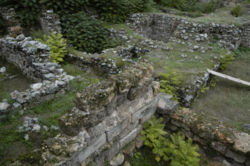
Cadmea
Encyclopedia

Citadel
A citadel is a fortress for protecting a town, sometimes incorporating a castle. The term derives from the same Latin root as the word "city", civis, meaning citizen....
of ancient Thebes, Greece
Thebes, Greece
Thebes is a city in Greece, situated to the north of the Cithaeron range, which divides Boeotia from Attica, and on the southern edge of the Boeotian plain. It played an important role in Greek myth, as the site of the stories of Cadmus, Oedipus, Dionysus and others...
, named after the legendary founder of Thebes, Cadmus
Cadmus
Cadmus or Kadmos , in Greek mythology was a Phoenician prince, the son of king Agenor and queen Telephassa of Tyre and the brother of Phoenix, Cilix and Europa. He was originally sent by his royal parents to seek out and escort his sister Europa back to Tyre after she was abducted from the shores...
. The area is thought to have been settled since at least the early Bronze Age
Bronze Age
The Bronze Age is a period characterized by the use of copper and its alloy bronze as the chief hard materials in the manufacture of some implements and weapons. Chronologically, it stands between the Stone Age and Iron Age...
, although the history of settlement can only be reliably dated from the late Mycenaean
Mycenaean Greece
Mycenaean Greece was a cultural period of Bronze Age Greece taking its name from the archaeological site of Mycenae in northeastern Argolis, in the Peloponnese of southern Greece. Athens, Pylos, Thebes, and Tiryns are also important Mycenaean sites...
period (c. 1400 BC onwards).
Classical period
In the Classical and early Hellenistic periods, the Cadmea served a similar purpose to the AcropolisAcropolis
Acropolis means "high city" in Greek, literally city on the extremity and is usually translated into English as Citadel . For purposes of defense, early people naturally chose elevated ground to build a new settlement, frequently a hill with precipitous sides...
of Athens
Athens
Athens , is the capital and largest city of Greece. Athens dominates the Attica region and is one of the world's oldest cities, as its recorded history spans around 3,400 years. Classical Athens was a powerful city-state...
; many public buildings were situated there, and the assemblies of Thebes and the Boeotian Confederacy are thought to have met there. During the Sparta
Sparta
Sparta or Lacedaemon, was a prominent city-state in ancient Greece, situated on the banks of the River Eurotas in Laconia, in south-eastern Peloponnese. It emerged as a political entity around the 10th century BC, when the invading Dorians subjugated the local, non-Dorian population. From c...
n (382-379/2 BC) and Macedon
Macedon
Macedonia or Macedon was an ancient kingdom, centered in the northeastern part of the Greek peninsula, bordered by Epirus to the west, Paeonia to the north, the region of Thrace to the east and Thessaly to the south....
ian occupations of Thebes, the foreign garrisons were stationed on the Cadmea.
Destruction and rebuilding
The Cadmea was destroyed by Alexander the Great in 335, who razed the city of Thebes as a warning to other Greek cities contemplating revolt against his rule. CassanderCassander
Cassander , King of Macedonia , was a son of Antipater, and founder of the Antipatrid dynasty...
, the Macedonian general who inherited the Greek territorial possessions of Alexander the Great after his death, rebuilt the Cadmea in 316 BC.
Different meaning of cadmea
Cadmea is also an ancient name for calamine or zinc carbonate. Combined with copper it was used in ancient (Roman) times for the production of brass (copper-zinc alloy), as mentioned for instance by the Roman author PliniusPliny the Elder
Gaius Plinius Secundus , better known as Pliny the Elder, was a Roman author, naturalist, and natural philosopher, as well as naval and army commander of the early Roman Empire, and personal friend of the emperor Vespasian...
(Pliny) the elder. The element Cadmium
Cadmium
Cadmium is a chemical element with the symbol Cd and atomic number 48. This soft, bluish-white metal is chemically similar to the two other stable metals in group 12, zinc and mercury. Similar to zinc, it prefers oxidation state +2 in most of its compounds and similar to mercury it shows a low...
(Cd) was isolated for the first time in 1817 from an impurity in calamine, hence the name Cadmium.

